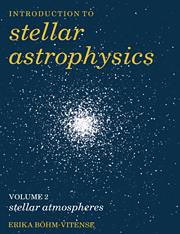Book contents
- Frontmatter
- Contents
- Preface
- 1 Stellar magnitudes and stellar colors
- 2 Stellar spectra
- 3 Temperature estimates for stars
- 4 Basics about radiative transfer
- 5 Radiative transfer in stellar atmospheres
- 6 The depth dependence of the source function
- 7 The continuous absorption coefficient
- 8 The influence of the non-greyness of the absorption coefficient
- 9 The pressure stratification
- 10 Theory of line formation
- 11 The hydrogen lines
- 12 Spectrum analysis
- 13 Basics about non-local thermodynamic equilibrium
- 14 The hydrogen convection zone
- 15 Stellar chromospheres, transition layers, and coronae
- 16 Stellar winds
- Problems
- Appendix LTE model stellar atmospheres
- References
- Index
5 - Radiative transfer in stellar atmospheres
Published online by Cambridge University Press: 08 February 2010
- Frontmatter
- Contents
- Preface
- 1 Stellar magnitudes and stellar colors
- 2 Stellar spectra
- 3 Temperature estimates for stars
- 4 Basics about radiative transfer
- 5 Radiative transfer in stellar atmospheres
- 6 The depth dependence of the source function
- 7 The continuous absorption coefficient
- 8 The influence of the non-greyness of the absorption coefficient
- 9 The pressure stratification
- 10 Theory of line formation
- 11 The hydrogen lines
- 12 Spectrum analysis
- 13 Basics about non-local thermodynamic equilibrium
- 14 The hydrogen convection zone
- 15 Stellar chromospheres, transition layers, and coronae
- 16 Stellar winds
- Problems
- Appendix LTE model stellar atmospheres
- References
- Index
Summary
The radiative transfer equation
In the outer layers of the stars, heat transport must be by radiation, since there is no other means of transporting heat into the vacuum surrounding the star. (The extremely low density interstellar material cannot provide any other method of heat transport comparable to the radiative energy loss of a star. It therefore can be considered to be a vacuum in this context.) These outer layers, where heat transport is by radiation only, may be shallow in some stars and may extend almost to the center of the star in others, as we shall see later. In the following discussion, we shall consider the case in which these outer layers have a very large optical depth τλ (see Chapter 1) but a geometrical height which is small compared to the radius of the star. In the case of the sun, for instance, a layer with τλ = 10 at visual wavelength has a geometrical height of about 500 km, which is certainly small in comparison with the solar radius of 700 000 km. In this case the radius of curvature is much larger than the height of the layer and we can consider it as plane parallel, as we did with the Earth's atmosphere in Chapter 1.
As in Chapter 1, we consider the flow of radiative energy through this outer layer, which we call the atmosphere of the star. In contrast to the Earth's atmosphere, there is no solid star underneath, since the stellar temperatures are much too high to permit solidification – except perhaps in such exotic objects as the white dwarfs.
- Type
- Chapter
- Information
- Introduction to Stellar Astrophysics , pp. 39 - 50Publisher: Cambridge University PressPrint publication year: 1989



